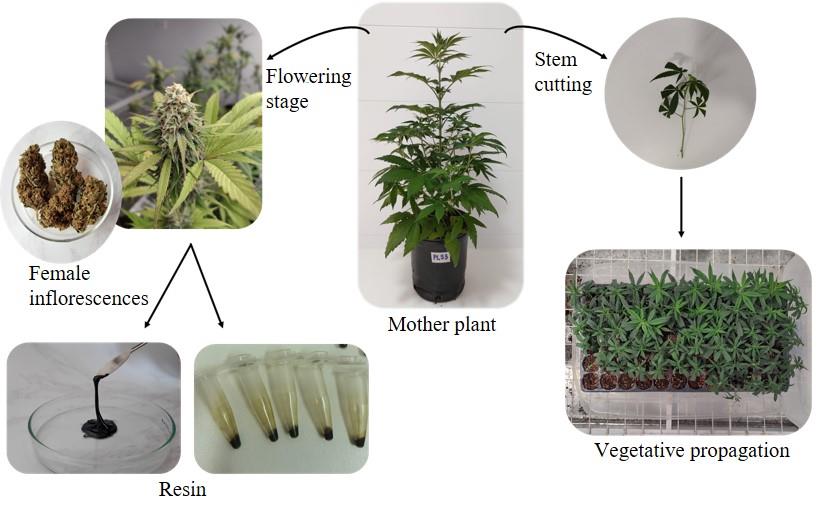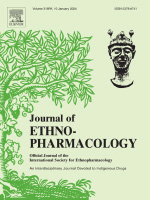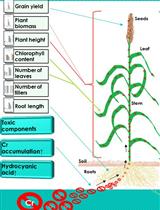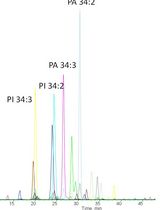- EN - English
- CN - 中文
Vegetative Propagation of Cannabis sativa and Resin Obtained From its Female Inflorescences
大麻的无性繁殖及其雌花序中提取得到的树脂
发布: 2025年02月20日第15卷第4期 DOI: 10.21769/BioProtoc.5204 浏览次数: 1580
评审: Noelia ForesiSimab KanwalAnonymous reviewer(s)
Abstract
Cannabis (Cannabis sativa L.) derivatives are of great importance in the medical, cosmetic, and pharmaceutical industries. This relevance is mainly due to the active principles (cannabinoids) found mainly in the trichomes of the female inflorescences. One of the most commonly used methods to propagate cannabis is by vegetative stem cuttings. This low-cost technique produces genetically uniform plants, ensuring consistent growth rates and cannabinoid production. The extraction of cannabinoids and other active compounds from the resin of the flowers is the main limitation of cannabis processing. Here, we describe a step-by-step protocol for propagating female cannabis plants from vegetative stem cuttings, inducing flower development, and obtaining high-quality cannabinoid-enriched resin.
Key features
• The propagation of cannabis is done by vegetative cuttings.
• It takes 4–5 months to cultivate the plant and obtain female inflorescences.
• Resin is the end product of the alcoholic extraction of flowers, and the obtained resin is a full-spectrum mixture of active compounds.
Keywords: Cannabis sativa (大麻)Graphical overview
 Main steps for the vegetative propagation of cannabis and extraction of resin from female inflorescences. The figure highlights the characteristics of the cutting and its arrangement in the corresponding tray. Additionally, it shows female inflorescences both in vivo and after harvesting and subsequent drying. From this point, different resin yields can be obtained depending on the protocol used.
Main steps for the vegetative propagation of cannabis and extraction of resin from female inflorescences. The figure highlights the characteristics of the cutting and its arrangement in the corresponding tray. Additionally, it shows female inflorescences both in vivo and after harvesting and subsequent drying. From this point, different resin yields can be obtained depending on the protocol used.
Background
Cannabis sativa L. is an annual dicotyledonous herbaceous plant of the Cannabaceae family [1]. Nowadays, the female plant is mainly used in the medical, cosmetic, and pharmaceutical industries. The development of new products in these health-related fields is mainly due to the therapeutic effects associated with various cannabinoids [2]. These compounds are present in trichomes, glandular structures located mainly in female inflorescences [3,4]. Currently, several subclasses of cannabinoids have been identified and categorized into 11 families, each containing a variable number of compounds. The best-known cannabinoids include tetrahydrocannabinol, cannabidiol, cannabinol, cannabichromene, cannabicyclol, and cannabigerol. In addition, there is a wide variety of terpenes, sugars, steroids, flavonoids, and nitrogenous compounds that give flavor and aroma to different strains and have synergistic effects with cannabinoids [5]. The ratios of active compounds in flowers are influenced by a number of factors, including plant genetics, growing and storage conditions, maturity at harvest, and the methods used to process and formulate the material [6].
To maintain the genetic stability of a plant with a specific chemical profile, asexual propagation by vegetative stem cutting is a very suitable method [7]. In this technique, a section of the plant is taken to create a clone that is genetically identical to the parent plant. It is then placed on a moist substrate to allow the roots to develop. When the root system is thriving, it is transplanted to its final location where the plant will grow vegetatively until it reaches flowering and subsequent cannabinoid production. Although this technique is simple, the success of this method depends on many variables such as plant genetics, explant characteristics, hormones, and growing conditions such as light, humidity, and temperature [8].
Once harvested, flowers should be trimmed and then dried (in the absence of sunlight to prevent photochemical transformation) before beginning extraction of the active compounds. Cannabinoids are located in the trichomes on the surface of the bud, where the concentration gradient between the solvent and the trichome surface acts as the primary barrier to chemical transfer. Ethanol is the solvent of choice because of its solubility, relatively low price, and more importantly, its boiling point (for recovery purposes). For medical or dietary applications, ethanol is preferred due to its lower toxicity [9]. After extraction, the solvent is removed to yield a resin consisting of cannabinoids, terpenes, and other accompanying compounds. Depending on the final use of the resin, additional steps for purification and/or isolation are required. In this paper, we specifically detail the procedure to effectively generate cuttings and then list the steps to achieve an efficient resin yield from an alcoholic extraction of cannabinoids.
Materials and reagents
Biological materials
1. Cannabis sativa L. plants
Reagents
1. Substrate GrowMix Multipro (Terrafertil)
2. Substrate enriched with worm castings, peat, river sand, pine needles, and perlite (Pura Pacha)
3. Root promoter, alpha naphthalene acetic acid 0.1 g/100 mL (Fertifox)
4. Ethanol 96% and 70% (Porta, CAS 64-17-5)
5. Sodium hypochlorite 30% (Odex, CAS 7681-52-9)
6. Fertilizer NPK 5-9-12 Top Bloom (Top Crop)
Laboratory supplies
1. Bootstrap farmer 72-cell tray (Carluccio)
2. Transparent plastic box 60 cm × 50 cm × 30 cm (Colombraro, catalog number: 257)
3. Pots (1 and 5 L) (Carluccio)
4. Falcon tubes 50 mL (Deltalab, catalog number: 429931)
5. Eppendorf tubes 1.5 mL (Deltalab, catalog number: 4092.2AM)
6. Pipette tips 1,000 μL (Deltalab, catalog number: 200070 309)
7. Airtight bags (Ziploc)
8. Beaker 250 mL (Borosil, catalog number: 1000D21)
9. Laboratory gloves (Fisher Scientific, catalog number: 19-130-1597B)
10. Qualitative filter paper Grade 1 (Whatman, catalog number: WHA1001125)
11. Scissors
Equipment
1. Cultivation room at 25 °C, 18/6 h light/dark photoperiod for vegetative stages and 12/12 h for floral stages. Led hell panels 400 W (Led Osram HyperRED 660 nm, Led duris E2836 4000K and 3000K, Cri80, Drivers Philips)
2. Homogenizer (IKA, model: T10 basic ULTRA-TURRAX)
3. PIPETMAN P1000L 100–1,000 μL (Gilson, model: F167370)
4. Analytical balance (Shimadzu, model: AUY220)
5. Automatic environmental SpeedVac system (Savant, model: AES1010)
6. Rotary evaporator (Dragon Lab, model: RE-100 PRO)
7. Centrifuge (Thermo Scientific, model: Sorvall ST16R)
Procedure
文章信息
稿件历史记录
提交日期: Sep 14, 2024
接收日期: Dec 16, 2024
在线发布日期: Jan 19, 2025
出版日期: Feb 20, 2025
版权信息
© 2025 The Author(s); This is an open access article under the CC BY-NC license (https://creativecommons.org/licenses/by-nc/4.0/).
如何引用
D´Ippolito, S., Landaburu, M., Vozza Berardo, M. E., Villamonte, M. D., Mendieta, J. R., Nercessian, D. and Colman, S. L. (2025). Vegetative Propagation of Cannabis sativa and Resin Obtained From its Female Inflorescences. Bio-protocol 15(4): e5204. DOI: 10.21769/BioProtoc.5204.
分类
植物科学 > 植物生物化学 > 代谢物
植物科学 > 植物育种 > 栽培技术
您对这篇实验方法有问题吗?
在此处发布您的问题,我们将邀请本文作者来回答。同时,我们会将您的问题发布到Bio-protocol Exchange,以便寻求社区成员的帮助。
提问指南
+ 问题描述
写下详细的问题描述,包括所有有助于他人回答您问题的信息(例如实验过程、条件和相关图像等)。
Share
Bluesky
X
Copy link












